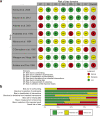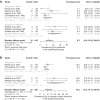Peritoneal dialysis catheter removal at the time or after kidney transplantation: a systematic review and meta-analysis
- PMID: 35945300
- PMCID: PMC9640428
- DOI: 10.1007/s00423-022-02637-y
Peritoneal dialysis catheter removal at the time or after kidney transplantation: a systematic review and meta-analysis
Abstract
Purpose: An increasing number of patients treated with peritoneal dialysis eventually undergo kidney transplantation. Owing to opposing reports, we aimed to find evidence about the best time for peritoneal dialysis catheter removal in transplant patients.
Methods: We conducted a systematic review and random effects meta-analysis of non-randomized studies of intervention comparing patients with peritoneal dialysis catheters left in place or removed during kidney transplantation in regard to the need for dialysis and occurrence of catheter-related complications. We searched (last update on 8 December 2021) PubMed, Embase, Scopus, and Web of Science for eligible studies. ROBINS-I tool and funnel plot asymmetry analysis were used to assess the quality of included articles.
Results: Eight observational studies were evaluated. Five of them, which involved 338 patients, were included in a meta-analysis. All were at moderate to serious risk of bias. The odds of needing dialysis are more than twice as high for patients with peritoneal dialysis catheters left in situ (pooled odds ratio, 2.21; 95% confidence interval [CI], 1.03 to 4.73; I2 = 0%). No statistically significant difference was noted when adult and pediatric subgroups were compared (Q = 0.13, P = .720). More individuals with catheters left in place required dialysis (pooled prevalence, 20.9%; 95% CI, 13.6 to 30.7%; I2 = 59% vs. 12.4%; 95% CI, 5.6 to 25.2%; I2 = 0%) and experienced catheter-related infections.
Conclusion: Available evidence is scarce. Unless new data from a randomized controlled trial are available, the dilemma of peritoneal dialysis catheter removal cannot be solved.
Trial registration: PROSPERO Protocol ID: CRD42020207707.
Keywords: Catheter removal; Delayed graft function; Kidney transplantation; Peritoneal dialysis catheter.
© 2022. The Author(s).
Conflict of interest statement
The authors declare no competing interests.
Figures






Similar articles
-
Comparison of cellulose, modified cellulose and synthetic membranes in the haemodialysis of patients with end-stage renal disease.Cochrane Database Syst Rev. 2001;(3):CD003234. doi: 10.1002/14651858.CD003234. Cochrane Database Syst Rev. 2001. Update in: Cochrane Database Syst Rev. 2005 Jul 20;(3):CD003234. doi: 10.1002/14651858.CD003234.pub2. PMID: 11687058 Updated.
-
Interventions for implementation of thromboprophylaxis in hospitalized patients at risk for venous thromboembolism.Cochrane Database Syst Rev. 2018 Apr 24;4(4):CD008201. doi: 10.1002/14651858.CD008201.pub3. Cochrane Database Syst Rev. 2018. PMID: 29687454 Free PMC article.
-
Strategies for the removal of short-term indwelling urethral catheters in adults.Cochrane Database Syst Rev. 2007 Apr 18;2007(2):CD004011. doi: 10.1002/14651858.CD004011.pub3. Cochrane Database Syst Rev. 2007. Update in: Cochrane Database Syst Rev. 2021 Jun 29;6:CD004011. doi: 10.1002/14651858.CD004011.pub4. PMID: 17443536 Free PMC article. Updated.
-
Early versus late ureteric stent removal after kidney transplantation.Cochrane Database Syst Rev. 2018 Jan 29;1(1):CD011455. doi: 10.1002/14651858.CD011455.pub2. Cochrane Database Syst Rev. 2018. PMID: 29376218 Free PMC article.
-
Electronic cigarettes for smoking cessation.Cochrane Database Syst Rev. 2022 Nov 17;11(11):CD010216. doi: 10.1002/14651858.CD010216.pub7. Cochrane Database Syst Rev. 2022. Update in: Cochrane Database Syst Rev. 2024 Jan 8;1:CD010216. doi: 10.1002/14651858.CD010216.pub8. PMID: 36384212 Free PMC article. Updated.
Cited by
-
Dialysis after kidney transplant failure: how to deal with this daunting task?J Nephrol. 2023 Sep;36(7):1777-1787. doi: 10.1007/s40620-023-01758-x. Epub 2023 Sep 7. J Nephrol. 2023. PMID: 37676635 Review.
-
Association between the geriatric nutritional risk index and clinical outcomes among peritoneal dialysis patients: A meta-analysis.Medicine (Baltimore). 2024 May 3;103(18):e38048. doi: 10.1097/MD.0000000000038048. Medicine (Baltimore). 2024. PMID: 38701289 Free PMC article.
References
Publication types
MeSH terms
LinkOut - more resources
Full Text Sources
Medical

